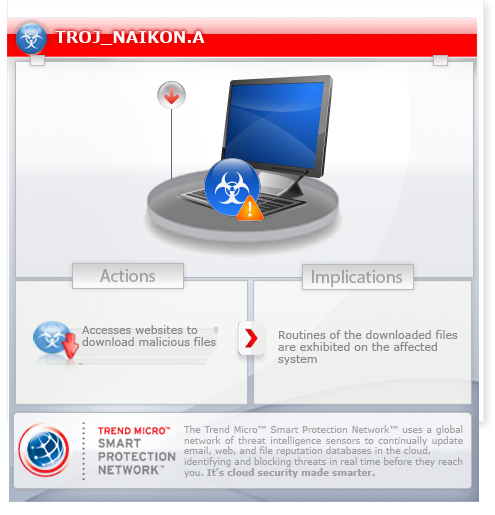TROJ_NAIKON.A
Windows 2000, Windows Server 2003, Windows XP (32-bit, 64-bit), Windows Vista (32-bit, 64-bit), Windows 7 (32-bit, 64-bit)


Threat Type: Trojan
Destructiveness: No
Encrypted: Yes
In the wild: Yes
OVERVIEW
This malware is the final payload of a targeted attack campaign leveraging the April 2013 Boston Marathon Bombing. It downloads malicious files onto the systems it infects. Affected users may find their systems infected with other malicious files that this malware downloads.
To get a one-glance comprehensive view of the behavior of this Trojan, refer to the Threat Diagram shown below.

This Trojan may be dropped by other malware.
However, as of this writing, the said sites are inaccessible.
TECHNICAL DETAILS
Arrival Details
This Trojan may be dropped by the following malware:
- TROJ_MDROP.ATP
Installation
This Trojan drops the following copies of itself into the affected system and executes them:
- %System%\ymsgr_tray.exe
(Note: %System% is the Windows system folder, which is usually C:\Windows\System32.)
It drops the following file(s)/component(s):
- {malware path}\profile.dat - blob file containing malware routines
It adds the following processes:
- iexplore.exe
It injects itself into the following processes as part of its memory residency routine:
- iexplore.exe
Autostart Technique
This Trojan adds the following registry entries to enable its automatic execution at every system startup:
HKEY_LOCAL_MACHINE\SOFTWARE\Microsoft\
Windows\CurrentVersion\Run
Yahoo! = ""%System%\ymsgr_tray.exe" -local"
Other Details
This Trojan attempts to access the following websites to download files, which are possibly malicious:
- {BLOCKED}point.{BLOCKED}p.net
However, as of this writing, the said sites are inaccessible.
NOTES:
The malware needs the following command line parameters in order to perform its intended routine:
- -{any string}cal
SOLUTION
Step 1
Before doing any scans, Windows XP, Windows Vista, and Windows 7 users must disable System Restore to allow full scanning of their computers.
Step 2
Remove the malware/grayware file that dropped/downloaded TROJ_NAIKON.A
- TROJ_MDROP.ATP
Step 3
Scan your computer with your Trend Micro product and note files detected as TROJ_NAIKON.A
Step 4
Restart in Safe Mode
Step 5
Delete this registry value
Important: Editing the Windows Registry incorrectly can lead to irreversible system malfunction. Please do this step only if you know how or you can ask assistance from your system administrator. Else, check this Microsoft article first before modifying your computer's registry.
- In HKEY_LOCAL_MACHINE\SOFTWARE\Microsoft\Windows\CurrentVersion\Run
- Yahoo! = ""%System%\ymsgr_tray.exe" -local"
- Yahoo! = ""%System%\ymsgr_tray.exe" -local"
Step 6
Search and delete this file
- {malware path}\profile.dat
Step 7
Restart in normal mode and scan your computer with your Trend Micro product for files detected as TROJ_NAIKON.A. If the detected files have already been cleaned, deleted, or quarantined by your Trend Micro product, no further step is required. You may opt to simply delete the quarantined files. Please check this Knowledge Base page for more information.
Did this description help? Tell us how we did.

